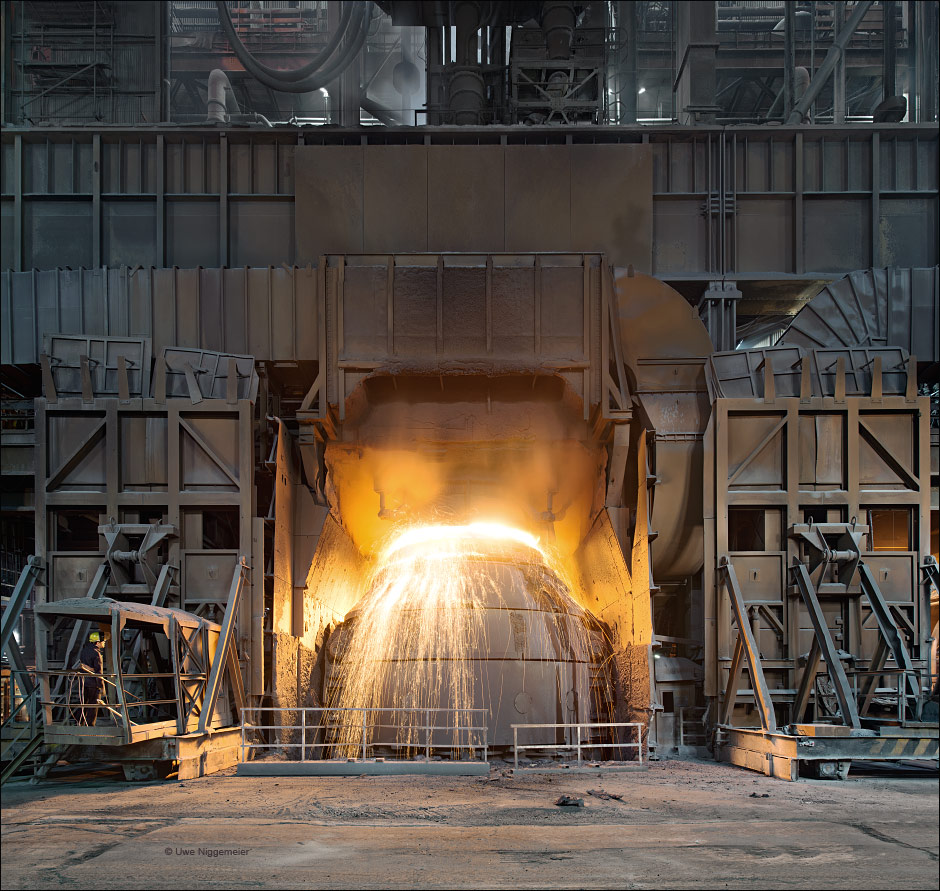
About 67% of the global crude steel total output is through the Basic Oxygen Furnace Steelmaking process and is recognized as the dominant steelmaking technology. In U.S alone the usage figure is 54% and slowly declining due primarily to the advent of the “Greenfield” electric arc furnace (EAF) flat-rolled mills. However, the method and technology is still in demand and being adapted by other regions.
Basic Oxygen Furnace (BOF) steel making or Basic Oxygen Furnace Steelmaking (BOS) or Linz-Donawitz-Verfahren steelmaking or the oxygen converter process is a method in which both molten pig iron and steel scrap are converted into steel with the oxidizing action of oxygen blown into the melt under a basic slag.
The Basic Oxygen Process, also called as Basic Oxygen Furnace, Basic Oxygen Steelmaking and Basic Oxygen Converter is the most powerful and effective steel making method and it is evident with the percentage of adaptation by the industry. The core of the process involves
- Furnace structure
- Refractory lining
- Chemical and physical processes
- Operation
Top & Bottom Blown Basic Oxygen Furnace
BOFs include conventional top-blown furnaces, bottom blown furnaces, and various mixed blowing configurations and inert gas bottom stirring modifications. The top blown basic oxygen furnace is equipped with the water cooled oxygen for blowing oxygen into the melt through 4-6 nozzles. Oxygen flow commonly reaches 200-280 ft3/(min*t) (6-8 m3/(min*t)). The oxygen pressure is 150-220 psi. Service life of oxygen lance is about 400 heats.
The bottom blown basic oxygen furnace is equipped with 15-20 tuyeres for injection of oxygen or lime powder containing oxygen. In this process, the tuyeres are cooled by either hydrocarbon gas or oil supplied to the outer jacket of the tube.
There are ways to extend production and optimize both blast furnaces and BOFs, but technological challenges exist. The steelmakers are experimenting with new and emerging technologies that, with more R & D, could overcome challenges. Because of significant higher new blast furnace capacity is not expected, steel plants are in need to find ways to meet demand by extending liquid pig iron production.
BOF comparison with EAF
Blast furnace-basic oxygen furnace uses iron ore as its base raw material that accounts over just 50% of BOF steel costs, and electric arc furnace uses scrap as its base that represents around 75% of EAF steel cost. The Basic Oxygen Steelmaking process differs from the EAF is that BOF is self-sufficient in energy. The primary raw materials for the BOP are 70-80% liquid hot metal from the blast furnace and the steel scrap need to be balanced. These are charged into the Basic Oxygen Furnace (BOF) vessel.
Oxygen (>99.5% pure) is “blown” into the BOF at supersonic velocities. It oxidizes the carbon and silicon contained in the hot metal liberating great quantities of heat which melts the scrap. There are lesser energy contributions from the oxidation of iron, manganese, and phosphorus.
A big difference between the two steelmaking processes however is in the capital investment costs involved. Whilst a typical integrated (i.e. BOF-route) steel mill today costs ~$1100 per tonne of installed capacity, a medium-size EAF-route mini-mill today costs under $300 per tonne in terms of the initial capital outlay.
As EAF steelmaking technology has improved in recent years with high quality steels are availability for EAF steelmakers. The difference in capital costs nonetheless means that EAF steelmaking is likely to grow proportionately more than BOF steelmaking in the coming years. The trend means that traditional BOF steelmakers such as US Steel are increasingly faced with important decisions concerning their choice of future steelmaking process route.
Air Products
In 1951, Air Products started an on-site gas supply concept to the steel industry and now its comprehensive range of industrial gases and cost efficient technologies can help users save money throughout their operations. The on-site gases supplied by Air Products are used in Guofeng Steel’s blast furnace and basic oxygen furnace for iron and steel making.
VESUVIUS
VESUVIUS offers a comprehensive range of refractory products for BOF, for primary linings as well as for repairs, that includes seating blocks – blended 98% pure fused / large crystal magnesia 15% carbon, magnesia castable, sleeves – blended 98% pure fused / large crystal magnesia 15% carbon and magnesia castable. While, the VESUVIUS supplies products, equipment and services for BOF Gunning Maintenance are BASIGUN Gunning Products, Gunning Equipment and Shooters and Laser System for reading lining thickness.
The Basic Oxygen Furnace Steelmaking is one of the top adaptable processes in today’s steel manufacturing process. Hence the supporting industries in the form of equipment suppliers, maintenance and services vendors have a large untapped market available in the global market.
